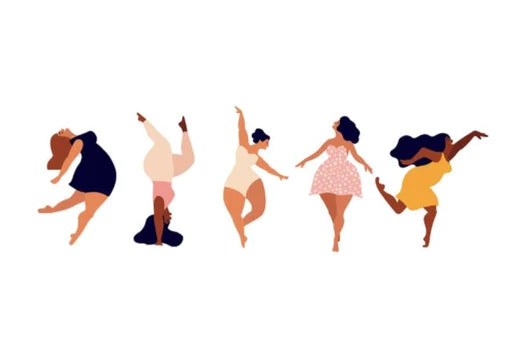
The Role of Resilience and Recovery in Overcoming Body Dysmorphia
KFTS BloggersShare
By Banafsha
The Role of Resilience and Recovery in Overcoming Body Dysmorphia

Introduction
Body dysmorphia, also known as body dysmorphic disorder (BDD), is a psychological condition characterized by a preoccupation with perceived flaws in one's physical appearance. This condition can lead to significant distress, anxiety, and impairment in daily functioning. Overcoming body dysmorphia requires a combination of resilience and recovery strategies to break free from the cycle of negative thoughts and self-destructive behaviors. In this blog, we will explore the importance of resilience in the context of body dysmorphia, as well as various recovery approaches that can empower individuals to reclaim their self-esteem and live fulfilling lives.
1. Understanding Body Dysmorphia and Its Impact
Body dysmorphia is a complex psychological disorder that affects millions of individuals worldwide. Those afflicted with BDD often experience a distorted perception of their physical appearance, fixating on minor or nonexistent flaws. This preoccupation leads to obsessive thoughts, repetitive behaviors (such as excessive grooming or mirror checking), and social withdrawal, perpetuating a cycle of negative self-perception (Phillips, 2005).
The psychological impact of body dysmorphia can be profound. Individuals may suffer from anxiety, depression, and social isolation due to their perceived physical imperfections. The relentless pursuit of "perfection" can lead to body dysmorphia becoming an all-consuming aspect of daily life, hindering personal growth and happiness.
2. Building Resilience in the Face of Body Dysmorphia
Resilience is the ability to bounce back from adversity and challenges, and it plays a pivotal role in overcoming body dysmorphia. While it is not a cure for the disorder, building resilience can help individuals navigate the difficult journey toward recovery. Here are some ways resilience can be cultivated:
2.1 Seek Professional Help
The first step in developing resilience is acknowledging the problem and seeking professional help. A qualified mental health professional, such as a psychologist or therapist, can provide a safe space to explore the underlying causes of body dysmorphia and develop coping mechanisms (Veale et al., 2016).
2.2 Establish a Support Network
Building a support network of friends, family, or support groups can significantly contribute to resilience. The understanding and encouragement of others can provide the necessary strength to face the challenges posed by body dysmorphia (Greenberg et al., 2016).
2.3 Practice Mindfulness and Self-Compassion
Mindfulness practices, such as meditation and deep breathing, can help individuals stay present and manage intrusive thoughts related to body dysmorphia. Practicing self-compassion and challenging negative self-talk can gradually reshape one's self-perception (Kelly et al., 2019).
III. Recovery Strategies for Overcoming Body Dysmorphia
In addition to building resilience, implementing specific recovery strategies is crucial in managing and overcoming body dysmorphia. These strategies aim to address the root causes of the disorder and foster positive changes in self-perception:
3.1 Cognitive-Behavioral Therapy (CBT)
CBT is an evidence-based therapeutic approach commonly used to treat body dysmorphia. This therapy focuses on identifying and challenging negative thought patterns and helping individuals develop healthier behaviors and coping mechanisms (Wilhelm et al., 2014).
3.2 Exposure and Response Prevention (ERP)
ERP is a specialized form of CBT that targets the compulsive behaviors associated with body dysmorphia. By gradually exposing individuals to situations that trigger their anxiety and resisting the urge to engage in compulsive behaviors, they can learn to manage their fears (Neziroglu et al., 2008).
3.3 Acceptance and Commitment Therapy (ACT)
ACT encourages individuals to accept their thoughts and feelings without judgment while committing to value-driven actions. By focusing on living a meaningful life, individuals can gradually shift their attention away from body dysmorphia and towards personal growth (Veale et al., 2013).
3.4 Medication
In some cases, medication may be prescribed to help manage the symptoms of body dysmorphia. Antidepressants, such as selective serotonin reuptake inhibitors (SSRIs), have shown to be beneficial in reducing obsessive-compulsive symptoms and depression associated with BDD (Koran et al., 2007).
Conclusion
Overcoming body dysmorphia is a challenging journey that requires both resilience and recovery strategies. Resilience empowers individuals to face the complexities of the disorder and seek professional help and social support. Recovery strategies, such as CBT, ERP, ACT, and medication, provide effective tools to challenge negative thought patterns and promote positive changes in self-perception. By combining resilience with evidence-based recovery approaches, individuals can break free from the grip of body dysmorphia and embrace their authentic selves, fostering a sense of empowerment, acceptance, and improved mental well-being.
To know more about 9 Ways to Support Your Loved Ones With Body Dysmorphia read here
To know more about Cultivating Mindfulness to Reduce Body Dysmorphia read here
Tags: #BodyDysmorphia #DysmorphicDisorder #BDD #Resilience #SelfEsteem #UnderstandingBodyDysmorphia #OvercomingBodyDismorphia
References
Greenberg, J. L., Mothander, P. R., Eisenberg, M. E., & Touyz, S. W. (2016). Systematic review and meta-analysis of resilience interventions among adolescents. Children and Youth Services Review, 61, 12-20.
Koran, L. M., Abujaoude, E., Large, M. D., & Serpe, R. T. (2008). The prevalence of body dysmorphic disorder in the United States adult population. CNS Spectrums, 13(4), 316-322.
Neziroglu, F., Khemlani-Patel, S., & Veale, D. (2008). Social learning theory and cognitive behavioral models of body dysmorphic disorder. Body Image, 5(1), 28-38.

